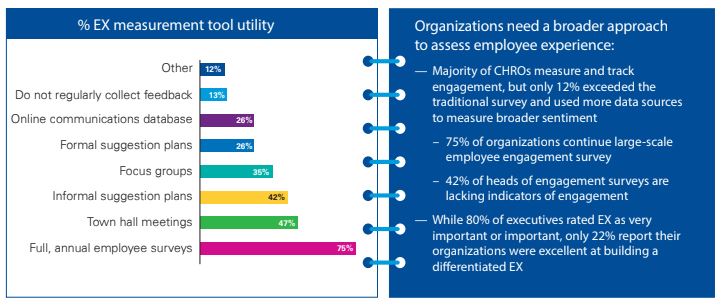Introduction
It is a time of unprecedented change and competition for companies across all sectors and sizes. Most organizations are facing increasing pressures from fast- growing start-ups disrupting traditional business models, new technologies that are reshaping operations, slimmer margins, and changing customer expectations. The workforce is also in the midst of a huge upheaval. Millennials now make up about half of the global workforce. Baby boomers are postponing their retirements and working longer.
And Generation Z is now entering the workforce in growing numbers. Each demographic brings its own views on work. For example, millennials are looking for experiences that connect with their values, a big shift from baby boomers, who typically view work as a means to an end and separate from their personal priorities. Generation Z takes an entrepreneurial approach to work and seeks out new opportunities and flexible work structures.1 As the workforce evolves, with more distinct and diverse objectives and expectations, organizations are also adapting to the impact of automation and other new technologies that are shifting not only where and how we work, but also business and operating models.
In this new workplace reality, companies must continuously reinvent themselves to respond to market change. A reinvention of the company’s talent strategy and workforce composition is a key part of that transformation. CEOs are looking to their chief human resource officers (CHROs) to ensure the organization has the right people, skill sets, and agility required to compete in an increasingly complex and competitive marketplace. Employee experience plays a critical role in reaching these goals. CHROs and other executives need to think differently about the value of employee experience, as well as their role in creating and maintaining a positive experience to help build and maintain a competitive advantage.

The need for personalized employee experiences
In KPMG’s survey report of the Future of HR 2019, 85 percent of respondents indicated that employee experience and engagement is the most valuable HR capability for the organization. Yet only 24 percent reported that employee experience is a priority for the next one to two years, and fewer (16 percent) indicated that employee experience was a top management board priority for HR to address.
Given the pace of change, this disconnect is concerning. Employee experience has never been more important for organizations looking to succeed. Leading companies are those that will employ an increasingly diverse mix of talent across demographics and role types, including full-time employees, contractors, and gig workers.
To attract, engage, and retain needed talent, companies must deliver a new kind of employee experience one that feels personal, relevant, and responsive to individual needs. This will require providing a technological experience at work that empowers employees to seamlessly collaborate and
innovate. And, you’ll want to create a sociocultural experience that gives employees a sense of purpose and that shows their personal values are in alignment with the organization’s values. The physical workspace can also create an environmental experience that encourages collaboration and multi-sensory simulation.
Sociocultural experience
The social experience consists of the values, attitudes, and culture that exist in the workplace. An organization’s structure, hierarchy, and leadership, as well as the relationships built between employees, can greatly influence overall employee experience (EX).
While individuals have always had high expectations of their employers, the nature of those expectations is now shifting, influenced by consumer interactions with brands, particularly on digital platforms. Today’s employees want on-demand access to data, modern tools and technology, easy transitions between different types of work, and a holistic experience where they can provide meaningful contributions in line with their personal values. Failing to meet these expectations results in significant dissatisfaction, turnover, and challenges with talent attraction and hiring.
Digital experience
The digital experience, such as the Internet of Things, mobility, and seamless interfaces, has changed how employees approach tasks and ultimately do their job. Employees seek a digital experience that is seamless and intuitive so that they can spend more time focusing on the task at hand.
Organizations need to design employee experiences that fit these evolving needs, starting with the recruitment of talent, but also continuing through to their journey as longer-term employees. Existing employees also need to be engaged, or reengaged.
Environmental experience
The environmental experience refers to both the physical and non-physical space. Environments should foster connection, collaboration, and flexibility, as well as boost concentration and productivity.
10%: Strong customer metrics for business units with engagement and connection scores in the top 25 percent.
36%: Higher employee retention at organizations with highly engaged employees.
147%: The percentage at which companies with highly engaged employees outperform their competitors.
20%: Increase in business sales when employees are highly engaged in their work.
4x: Higher profitability at companies investing in EX versus those who don’t.

Developing the employee experience
For most organizations, redesigning an employee experience requires a shift in mind-set, one that recognizes that today’s employees think and act like consumers and want to be treated as “internal customers.” Employers must look at operations through a customer experience (CX) lens. This approach will allow HR to better understand what each worker wants and needs from their career, their workplace, and their employer. From there, they can begin to shape the experience. Another critical step in developing a positive employee experience is revisiting your employee value proposition (EVP).A compelling EVP not only helps shape worker expectations but can also help to articulate how the organization will meet and exceed those expectations.
What are the expectations your organization is consciously and unconsciously setting for employees? The answer usually sets the framework for understanding the expectations that will be put in place in the future. If the experience does not live up to the expectations, there is a
gap, which in turn can lead to lower staff retention.
Creating and maintaining a clear and compelling EVP—or multiple EVPs—will be an important differentiator moving forward. In fact, 37 percent of global HR executives in our Future of HR Survey indicated that managing multiple EVPs for a multigenerational workforce or different employee
types will be a critical skill for HR in coming years, with 15 percent ranking this area as their top choice. Consider your current EVP: Is it clearly defined? Has it been tested? Where are there gaps in your organization’s ability to deliver on its EVP? How do these gaps impact the business? Next, look at the core of your worker experience: the work itself.
Often, the tendency is to look at the workers’ experience in the organization as something separate from their work. This is a mistake. By making the work for which employees are responsible the foundation of the employee experience, you place a greater emphasis on the structural elements that shape that work and thus shape the employees’ day-to-day experiences within the organization. These can include areas such as job design, job architecture, and workflow optimization.
Throughout the process of examining and redesigning the EVP, remember to talk with your workers, rather than at them. By treating workers as valued internal customers, you work to create a collaborative relationship between HR and the individuals that you serve, and are better able to deliver a relevant and authentic value proposition. This process, in which true worker needs, wants, and frustrations are openly heard and addressed, creates internal brand ambassadors who “opt in” to the future of the organization.
Harrods: Applying CX to improve EX
For the past decade, retailers have been up against the Amazon effect and have been challenged to digitize while creating highly personalized experiences for shoppers. In order to meet these challenges and grow, Harrods has prioritized its employee strategy by creating a Learning & Development team to offer training and accredited education programs, coaching, and staff-led career week initiatives. It also established an employee forum called Your Voice to resolve issues and ensure employees feel heard, and sought opinions from potential job candidates to create its EVP. The result: Since 2007, Harrods has achieved double-digit growth, decreased labor turnover from 48 percent to 22 percent, and increased retention with 75 percent of employees staying for more than two years. It was also named the top consumer retailer in Glassdoor’s Best Places to Work.

HR as a platform
Not only must the employee’s work feel meaningful, but it should also be surrounded by a platform of human-centered services that are provided or supported by HR. This means that instead of focusing on process, the HR organization of the future will be more like a platform or service provider that meets the needs of different “internal customer” or worker groups in different ways. This is akin to the transformation that we see many companies making to embrace platform models to better meet consumer expectations.
One significant contributor to this type of service delivery, and to the employee experience in general, is the use of chatbots. Not only can chatbots provide real-time answers to common HR questions, but they are also an important way of servicing increasingly geographically diverse workforces, including remote workers and freelancers.
External companies specialize in building these types of HR bots, which can be trained on company policy documents, draw information from HCM back-end systems, and integrate seamlessly into corporate messaging systems. For example, an employee wanting to know how much vacation time they have left can simply text the question to the HR bot and it will recognize and access that employee’s records and instantly reply. Research shows organizations with specific employee experience programs and strategies report up to three times higher profit growth. Part of this growth is due to lower operating margins stemming from employees being more innovative in how they work, but lower employee turnover also contributes measurable savings. In these higher staff retention environments, managers seem to be more willing to engage with employees and have positive, constructive conversations.
Using information gathered through conversations with workers, as well as deep data and analytics, HR can segment workers into different groups and needs areas, such as what they want from their job, role type, workplace preferences, motivational drivers, and more. Through the platform model, HR can then provide targeted services to each group, connecting the right platform elements to the right worker types at the right time. These elements can range from traditional areas such as training, professional development, and guidance on career paths, to the tools and technologies that workers use in their roles. Instead of leaving these platform elements to other business functions, the HR organization of the future will weave them into a holistic experience that can be tailored as required to meet individual needs.
Salesforce: Using technology to manage and drive growth
In the past five years, Salesforce has more than doubled revenue and employee headcount. In order to keep up with the accelerated pace of growth and maintain quality, the software development company did what it does best: harnessed the power of technology to empower employees. Salesforce’s HR and IT teams worked together to develop a new, cloud-based intranet, known as Concierge, to allow employees to self-service their IT ticket questions at faster rates. The collaboration continued with the issuance of several employee apps including V2MOM, which enabled sharing of team goals, and an app to publish engagement survey results. The result: The company’s IT case volume and resolution time dropped 40 percent contributing to an improved employee satisfaction and productivity. Salesforce ranks highly in employee satisfaction, placing #7 on the Employee Experience Index.

Integrating data to better understand workers
Moving forward, rather than limiting insights to annual performance reviews or opinion services, HR should always have a finger on the pulse of the current employee experience. What do workers want across their digital, social, and environmental experiences, and is your organization meeting those needs? Mechanisms and technology that allow for real-time feedback and sentiment analysis may ensure that workers feel heard and allow the organization to respond swiftly in the moments that matter. This feedback can also provide opportunities to iterate on the delivered experience based on worker responses and fill the gaps between the EVP, workers’ expectations, and the current employee experience.
According to a recent study by Gartner, formal annual employee engagement surveys are declining, while other methods of acquiring and monitoring employee data are on the rise. Within organizations that have moved away from engagement surveys entirely, 64 percent report using “small-scale pulse surveys and one-off, topic-specific surveys to measure engagement.”
That said, the majority of organizations are still employing traditional, nonresponsive EX indicators. As HR’s data and analytics capabilities deepen, data usage can shift from assessing worker experience in the moment to anticipating shifts in needs, motivations, and drivers using predictive analytics. Part of this shift is taking advantage of and gaining additional value from other sources of data that already exist within the organization,
both from internal and external sources. This could include inputs from reference checks and responses to interview questions from the hiring process; information from day-to-day tasks such as conference call logs, calendaring, and travel management; and broader external inputs, such as social media. Such information contributes not only to the process of designing a tailored employee experience, but also ongoing customization and adaptation to current worker needs.

Delivering experiences to achieve value
Leading organizations are stepping back and considering the mind-set of workers. If your employees had the choice of whether or not to show up for
work tomorrow, would they? And how can you start influencing that decision? Employee experience is based on expectations: expectations that workers bring to the organization and that are shaped by the EVP and brand. In the organization of the future, HR will likely be the architect of employee experience and a “service provider” that delivers tailored working experiences that meet or exceed worker expectations.
As organizations continue to evolve, and attracting and retaining specialized skill sets becomes more challenging, HR functions that effectively deliver a responsive employee experience will likely be a significant contributor to competitive advantage. Employee experience is one of the five key areas that we believe should be at the forefront of the HR agenda to address the ongoing changes to the workforce and the needs of tomorrow’s organizations. For more on these priorities, and the critical shift in mind-set that HR needs to become a major driver of competitive advantage, download KPMG’s Future of HR report.
As organizations turn to digital labor to address workplace challenges, it is incumbent on HR leaders to protect the special elements of the culture
and employee experience to prevent a sterile work environment.
Southwest Airlines: Prioritizing employee engagement to improve the customer experience
In order to drive competitive advantage in a highly competitive, regulated, and unionized industry, Southwest Airlines has turned its focus to its employees and empowering them to take ownership in the company brand. To that end, it tasked employees to design a new flight attendant
uniform, and Southwest began issuing quarterly employee surveys to receive more real-time insight into employee engagement. The airline also
encouraged attendants to be creative and “funny” on safety announcements. The result: Southwest continues to rank as a top U.S. employer being the
only airline to place top 20 in the 2017 Employee Experience Index. Annual revenues have grown about $140 million after the airline encouraged
employees to get creative in engaging with customers on flights.

